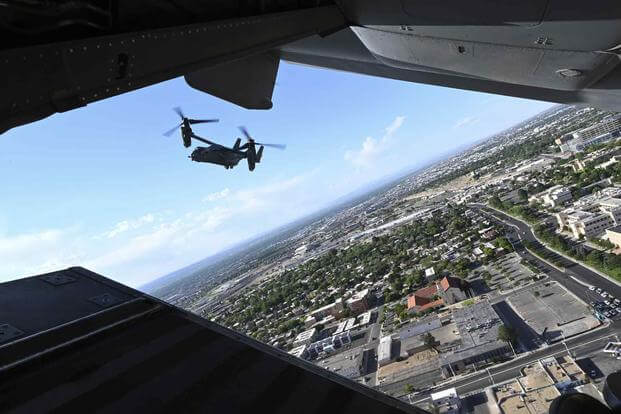
The Air Force has started to fly some of its CV-22 Ospreys again to assess the troubled aircraft’s flight eligibility, a notable step as the service works to return the entire fleet to full operations after a deadly crash late last year.
It is the last among the services to return its Ospreys to the air following the Nov. 29 crash off the coast of Japan that killed eight airmen and triggered a military-wide grounding of the aircraft. The Pentagon cleared all the services to begin flying the Osprey again in March, and several of the Air Force’s aircraft have undergone testing and evaluation.
“As each aircraft is cleared, our aircrew will immediately commence flight operations,” Lt. Col. Rebecca Heyse, an Air Force Special Operations Command spokeswoman, told Military.com on Monday. “As of today, several aircraft have conducted functional check flights, the first step in resuming flying operations.”
Read Next: Considering Fat-Loss Supplements? New Military Study Finds Many Are Not What They Seem.
In December, the V-22 Joint Program Office — part of Naval Air Systems Command — grounded the aircraft, which is flown by the Air Force, Marine Corps and Navy. In March, while lifting the grounding, that same office admitted that a new mechanical failure had led to the crash. Officials declined to provide specific details of what went wrong and why they felt confident putting Ospreys back in the air.
“We have high confidence that we understand what component failed, and how it failed,” Marine Corps Col. Brian Taylor, the program manager for the V-22 program, told reporters in March.
“I think what we are still working on is the ‘why,'” he added, noting that “this is the first time that we’ve seen this particular component fail in this way.”
Amid that uncertainty, the Air Force has taken a phased and slow approach to putting its CV-22s back in the air. Lt. Gen. Tony Bauernfeind, the head of Air Force Special Operations Command, convened a safety investigation board and an accident investigation board, in addition to conducting a comprehensive review of the Air Force CV-22 force as a whole following the crash.
Heyse told Military.com that the safety investigation board has been completed, while the accident investigation board and other reviews are ongoing.
“The AFSOC CV-22 fleet is executing the deliberate return-to-flight process,” Heyse said. “This process includes simulator training for our CV-22 aircrew, maintenance inspections of our CV-22 aircraft, and a review of each aircraft’s maintenance records as prescribed by the Joint Program Office.”
By contrast, the Marine Corps began putting its Ospreys back in the skies by March 14 — less than a week after the hold was lifted. Similarly, the Navy told Military.com in late March that it had begun flying some of its stateside Ospreys again.
Japan’s Ground Self-Defense Force, which also flies the Osprey, resumed flights in March, according to a report from Japan Times.
The November crash is only the latest issue for the Air Force’s Ospreys. In August 2022, the service briefly grounded its V-22 fleet after it experienced a series of hard clutch engagements that worried leaders.
The hard clutch problem is an ongoing issue with the Osprey’s complex system of clutch assemblies that is supposed to enable one engine to fly the aircraft in the event of an engine failure. However, those clutches have failed in some instances.
Military.com reported one such mishap with an Air Force Osprey that could have been fatal in 2017.
Related: Air Force Ospreys in Japan Remain Grounded After Deadly Crash, Even as Marines Return to the Air






